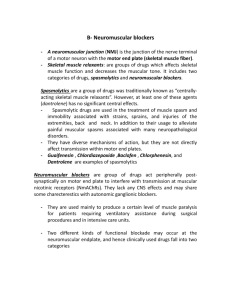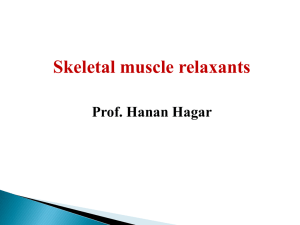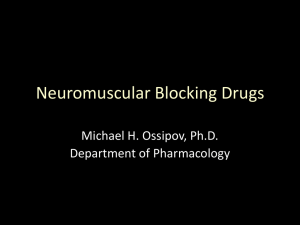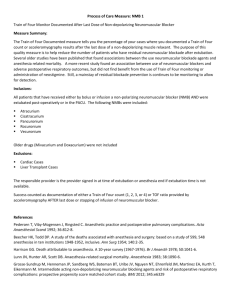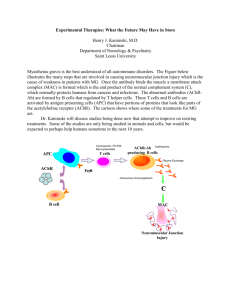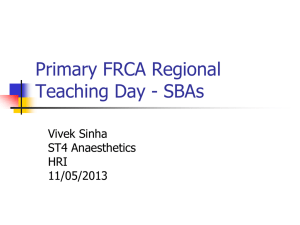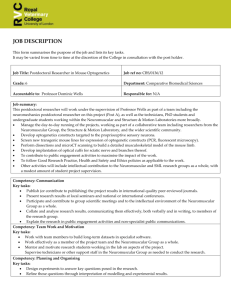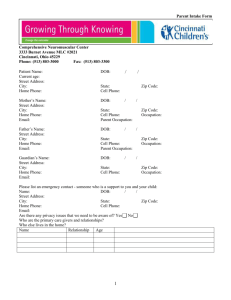Annex I: CSP
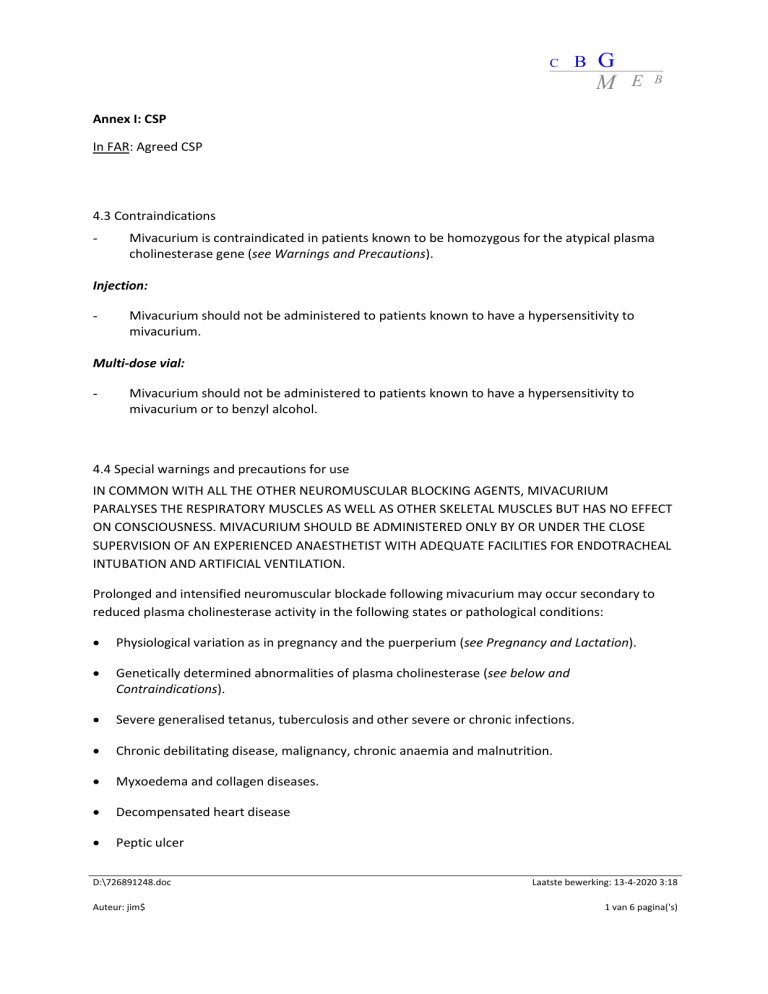
C
B G
M E B
Annex I: CSP
In FAR: Agreed CSP
4.3 Contraindications
Mivacurium is contraindicated in patients known to be homozygous for the atypical plasma cholinesterase gene (see Warnings and Precautions).
Injection:
Mivacurium should not be administered to patients known to have a hypersensitivity to mivacurium.
Multi-dose vial:
Mivacurium should not be administered to patients known to have a hypersensitivity to mivacurium or to benzyl alcohol.
4.4 Special warnings and precautions for use
IN COMMON WITH ALL THE OTHER NEUROMUSCULAR BLOCKING AGENTS, MIVACURIUM
PARALYSES THE RESPIRATORY MUSCLES AS WELL AS OTHER SKELETAL MUSCLES BUT HAS NO EFFECT
ON CONSCIOUSNESS. MIVACURIUM SHOULD BE ADMINISTERED ONLY BY OR UNDER THE CLOSE
SUPERVISION OF AN EXPERIENCED ANAESTHETIST WITH ADEQUATE FACILITIES FOR ENDOTRACHEAL
INTUBATION AND ARTIFICIAL VENTILATION.
Prolonged and intensified neuromuscular blockade following mivacurium may occur secondary to reduced plasma cholinesterase activity in the following states or pathological conditions:
Physiological variation as in pregnancy and the puerperium (see Pregnancy and Lactation).
Genetically determined abnormalities of plasma cholinesterase (see below and
Contraindications).
Severe generalised tetanus, tuberculosis and other severe or chronic infections.
Chronic debilitating disease, malignancy, chronic anaemia and malnutrition.
Myxoedema and collagen diseases.
Decompensated heart disease
Peptic ulcer
D:\726891248.doc
Auteur: jim$
Laatste bewerking: 13-4-2020 3:18
1 van 6 pagina('s)
C
B G
M E B
Burns (see below)
End-stage hepatic failure, (see Dosage and Administration)
Acute, chronic or end-stage renal failure (see Dosage and Administration).
Iatrogenic: following plasma exchange, plasmapheresis, cardiopulmonary bypass, and as a result of concomitant drug therapy (see Interactions).
In common with suxamethonium/succinylcholine, patients homozygous for the atypical plasma cholinesterase gene (1 in 2500 patients) are extremely sensitive to the neuromuscular blocking effect of mivacurium. In three such adult patients, a small dose of mivacurium 0.03 mg/kg
(approximately the ED
10-20
in genotypically normal patients), produced complete neuromuscular block for 26 to 128 min.
In patients heterozygous for the atypical plasma cholinesterase gene, the clinically effective duration of block of mivacurium 0.15 mg/kg is approximately 10 min longer than in control patients.
Once spontaneous recovery had begun, neuromuscular block in these patients was antagonized with conventional doses of neostigmine.
Patients with burns may develop resistance to non-depolarising neuromuscular blocking agents and require increased doses. However, such patients may also have reduced plasma cholinesterase activity, requiring dose reduction. Consequently, burn patients should be given a test dose of 0.015 to 0.020 mg/kg mivacurium followed by appropriate dosing guided by monitoring of block with a nerve stimulator.
Caution should be exercised in administering mivacurium to patients with a history suggestive of an increased sensitivity to the effects of histamine e.g. asthma. If mivacurium is used in this group of patients it should be administered over 60 seconds.
Caution should also be exercised when administering mivacurium to patients who have shown hypersensitivity to other neuromuscular blocking agents since a high rate of cross-sensitivity (greater than 50%) between neuromuscular blocking agents has been reported.
Mivacurium should be administered over a period of 60 seconds to patients who may be unusually sensitive to falls in arterial blood pressure, for example those who are hypovolaemic.
In adults, doses of mivacurium of greater than or equal to 0.2 mg/kg (greater than or equal to 3x
ED
95
) have been associated with histamine release when administered by rapid bolus injection.
However, the slower administration of the 0.2 mg/kg mivacurium dose and the divided administration of the 0.25 mg/kg mivacurium dose (see Dosage and Administration) minimise the cardiovascular effects of these doses. Cardiovascular safety did not appear to be compromised in children given a rapid bolus dose of 0.2 mg/kg in clinical studies.
D:\726891248.doc
Auteur: jim$
Laatste bewerking: 13/04/2020 3:18 AM
2 van 6 pagina('s)
C
B G
M E B
Mivacurium does not have significant vagal or ganglion blocking properties in the recommended dosage range. Recommended doses of mivacurium consequently have no clinically significant effects on heart rate and will not counteract the bradycardia produced by many anaesthetic agents or by vagal stimulation during surgery.
In common with other non-depolarising neuromuscular blocking agents, increased sensitivity to mivacurium can be expected in patients with myasthenia gravis, other forms of neuromuscular disease and cachectic patients. Severe acid-base or electrolyte abnormalities may increase or reduce sensitivity to mivacurium.
Mivacurium solution is acidic (approximately pH 4.5) and should not be mixed in the same syringe or administered simultaneously through the same needle with highly alkaline solutions (e.g. barbiturate solutions). It has been shown to be compatible with some commonly used peri-operative drugs supplied as acidic solutions, e.g. fentanyl, alfentanil, sufentanil, droperidol and midazolam. Where other anaesthetic agents are administered through the same indwelling needle or cannula as used for mivacurium, and compatibility has not been demonstrated, it is recommended that each drug is flushed through with physiological saline.
Studies in malignant hyperthermia-susceptible pigs indicated that mivacurium does not trigger this syndrome. Mivacurium has not been studied in malignant hyperthermia-susceptible patients.
Reversal of neuromuscular block: As with other neuromuscular blocking agents, evidence of spontaneous recovery should be observed prior to administration of reversal agent (e.g. neostigmine). The use of a peripheral nerve stimulator to evaluate recovery prior to and following reversal of neuromuscular block is strongly recommended.
No data are available on the long-term use of mivacurium in patients undergoing mechanical ventilation in the intensive care unit.
Multi-dose vial:
Benzyl alcohol is used as an antimicrobial preservative in many parenteral drug formulations.
Theoretically, certain patient groups, e.g. those with liver failure, may possess a reduced ability to metabolise benzyl alcohol. There have been reports linking the use of parenteral drug formulations containing benzyl alcohol to morbidity and mortality amongst low weight neonates.
4.5 Interactions with other medicinal products and other forms of interaction
The neuromuscular block produced by mivacurium may be potentiated by the concomitant use of inhalational anaesthetics such as enflurane, isoflurane, sevoflurane and halothane.
D:\726891248.doc
Auteur: jim$
Laatste bewerking: 13/04/2020 3:18 AM
3 van 6 pagina('s)
C
B G
M E B
Mivacurium has been safely administered following suxamethonium-facilitated tracheal intubation.
Evidence of spontaneous recovery from suxamethonium should be observed prior to administration of mivacurium.
In common with all non-depolarising neuromuscular blocking agents the magnitude and/or duration of a non-depolarising neuromuscular block may be increased and maintenance requirements may be reduced as a result of interaction with:
-
-
-
-
-
-
Antibiotics, including the aminoglycosides, polymyxins, spectinomycin, tetracyclines, lincomycin and clindamycin
Anti-arrhythmic drugs: propranolol, calcium channel blockers, lignocaine, procainamide and quinidine.
Diuretics: frusemide and possibly thiazides, mannitol and acetazolamide.
Magnesium salts.
Ketamine.
Lithium salts.
Ganglion blocking drugs: trimetaphan, hexamethonium. -
Drugs that may reduce plasma cholinesterase activity may also prolong the neuromuscular blocking action of mivacurium. These include anti-mitotic drugs, monoamine oxidase inhibitors, ecothiopate iodide, pancuronium, organophosphates, anticholinesterases, certain hormones, bambuterol.
Rarely, certain drugs may aggravate or unmask latent myasthenia gravis or actually induce a myasthenic syndrome; increased sensitivity to mivacurium would be consequent on such a development. Such drugs include various antibiotics, beta-blockers (propranolol, oxprenolol), antiarrhythmic drugs (procainamide, quinidine), antirheumatic drugs (chloroquine, D-pencillamine), trimetaphan, chlorpromazine, steroids, phenytoin and lithium.
The administration of combinations of non-depolarising neuromuscular blocking agents in conjunction with mivacurium may produce a degree of neuromuscular blockade in excess of that which might be expected from an equipotent total dose of mivacurium. Any synergistic effect may vary between different drug combinations.
A depolarising muscle relaxant such as suxamethonium chloride should not be administered to prolong the neuromuscular blocking effects of non- depolarising agents, as this may result in a prolonged and complex block which can be difficult to reverse with anti-cholinesterase drugs.
4.6 Fertility, pregnancy and lactation
Fertility
Fertility studies have not been performed.
D:\726891248.doc
Auteur: jim$
Laatste bewerking: 13/04/2020 3:18 AM
4 van 6 pagina('s)
C
B G
M E B
Pregnancy
Animal studies have indicated that mivacurium has no adverse effect on foetal development.
Mivacurium should not be used during pregnancy unless the expected clinical benefit to the mother outweighs any potential risk to the foetus.
Plasma cholinesterase levels decrease during pregnancy. Mivacurium has been used to maintain neuromuscular block during Caesarean section, but due to the reduced levels of plasma cholinesterase, dosage adjustments to the infusion rate were necessary. A further reduction in the infusion rate may also be required during Caesarean section in patients pre-treated with MgSO
4
, due to the potentiating effects of Mg 2+ .
Breast-feeding
It is not known whether mivacurium is excreted in human milk.
4.7 Ability to perform tasks that require judgement, motor or cognitive skills
This precaution is not relevant to the use of mivacurium. Mivacurium will always be used in combination with a general anaesthetic and therefore the usual precautions relating to performance of tasks following general anaesthesia apply.
4.8 Undesirable effects
Adverse events are listed below by system organ class and frequency. Frequencies are defined as: very common (>1/10), common (>1/100, <1/10), uncommon (>1/1000, <1/100), rare (>1/10000,
<1/1000) and very rare (<1/10,000) including isolated reports.
Immune disorders
Very rare: Severe anaphylactic or anaphylactoid reaction. Severe anaphylactic or anaphylactoid reactions have been reported in patients receiving mivacurium chloride in conjunction with one or more anaesthetic agents.
Cardiac disorders
Uncommon:
Vascular disorders
Transient tachycardia†
D:\726891248.doc
Auteur: jim$
Laatste bewerking: 13/04/2020 3:18 AM
5 van 6 pagina('s)
C
B G
M E B
Very common: Flushing†
Uncommon: Hypotension†
Respiratory, thoracic and mediastinal disorders
Uncommon: Bronchospasm†
Skin and subcutaneous tissue disorders
Uncommon: Erythema†, urticaria†
†Associated with the use of mivacurium there have been reports of skin flushing, erythema, urticaria, hypotension, transient tachycardia or bronchospasm which have been attributed to histamine release. These effects are dose-related and more common following initial doses of
0.2 mg/kg or more when given rapidly and are reduced if mivacurium chloride is injected over
30 to 60 seconds or in divided doses over 30 seconds.
4.9 Overdose
Symptoms and Signs
Prolonged muscle paralysis and its consequences are the main effects of overdosage with neuromuscular blocking agents. However, the risk of haemodynamic side effects, especially decreases in blood pressure may be increased.
Treatment
It is essential to maintain a patent airway together with assisted positive pressure ventilation until spontaneous respiration is adequate.
Full sedation will be required since consciousness is not impaired.
Recovery may be hastened by the administration of anticholinesterase agents accompanied by atropine or glycopyrrolate, once evidence of spontaneous recovery is present. Cardiovascular support may be provided by proper positioning of the patient and administration of fluids or vasopressor agents as required.
D:\726891248.doc
Auteur: jim$
Laatste bewerking: 13/04/2020 3:18 AM
6 van 6 pagina('s)
